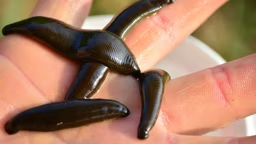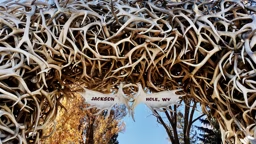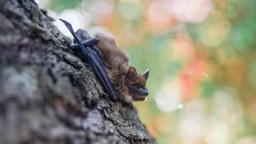From a distance, the flower garden appeared to shimmer in the bright sunlight. But a closer look revealed – strung from stakes and fluttering in the wind – almost as many CDs as zinnias. I wasn’t sure whether the CDs were meant to frighten the deer, or whether the cottage owners hoped the deer would be as offended by the volumes of direct-mail promotional CDs as they were. Either way, here was just another creative solution used by frustrated gardeners to protect their turf from one of the country’s biggest wildlife problems: deer.
A healthy deer consumes about 3 percent of its body weight in forage each day, requiring from 4,000 to 6,000 calories or 4 to 10 pounds of foliage. Although that may not sound like a lot, it is about the equivalent greenery required to prepare a garden salad for a party of 50 people. Multiply that amount by a current population of about 20 million deer in the United States, and it’s no wonder that unprotected gardens suffer.
Desperate gardeners have four basic options for making their garden undeersirable. These include fences, scare tactics, homemade or commercially available taste and smell repellents and unpalatable landscaping (Cornell University has developed a list of unpalatable plants, but experience tells me many deer haven’t read it).
Sad to say, the only way to completely escape deer damage is to build a well-reinforced, 8-foot tall fence. Short of that, the best defense is to understand how deer use their senses and experiment with multiple deterrents.
Although deer may seem brazen, they are skittish by nature and use their senses to alert them to potential danger. Since deer learn to adapt rather quickly, rotating your tactics is necessary to keep them guessing.
Fence It Off
While fences can be unsightly, and impractical in some spots – like along the flowerbed next to your cabin, or in a place where it obstructs your view – they can be highly effective.
Of course a fence must be several feet high since deer are good leapers. A height of 8 to 10 feet, while relatively expensive, is recommended. Cabin owners in northern areas must consider that a tall snowdrift can allow deer passage over most fences. Deer can also crawl under fences, so the fence also must be tight to the ground.
There are black mesh fences touted as “virtually invisible.” This is supposed to provide two benefits: (1) It’s easier on human eyes, but (2) It’s hard for deer to see, making them fearful of it. Just remember to warn unsuspecting guests about your hard-to-see fence!
Electrified fences are sometimes used to keep deer away, but you may not want to use them near children and pets.
Many fencing options are available (see chart at right). Before installing a fence of any kind, keep in mind that it will need to be maintained.
A healthy deer consumes about 3 percent of its body weight in forage each day, requiring from 4,000 to 6,000 calories or 4 to 10 pounds of foliage. Although that may not sound like a lot, it is about the equivalent greenery required to prepare a garden salad for a party of 50 people. Multiply that amount by a current population of about 20 million deer in the United States, and it’s no wonder that unprotected gardens suffer.
Desperate gardeners have four basic options for making their garden undeersirable. These include fences, scare tactics, homemade or commercially available taste and smell repellents and unpalatable landscaping (Cornell University has developed a list of unpalatable plants, but experience tells me many deer haven’t read it).
Sad to say, the only way to completely escape deer damage is to build a well-reinforced, 8-foot tall fence. Short of that, the best defense is to understand how deer use their senses and experiment with multiple deterrents.
Although deer may seem brazen, they are skittish by nature and use their senses to alert them to potential danger. Since deer learn to adapt rather quickly, rotating your tactics is necessary to keep them guessing.
Fence It Off
While fences can be unsightly, and impractical in some spots – like along the flowerbed next to your cabin, or in a place where it obstructs your view – they can be highly effective.
Of course a fence must be several feet high since deer are good leapers. A height of 8 to 10 feet, while relatively expensive, is recommended. Cabin owners in northern areas must consider that a tall snowdrift can allow deer passage over most fences. Deer can also crawl under fences, so the fence also must be tight to the ground.
There are black mesh fences touted as “virtually invisible.” This is supposed to provide two benefits: (1) It’s easier on human eyes, but (2) It’s hard for deer to see, making them fearful of it. Just remember to warn unsuspecting guests about your hard-to-see fence!
Electrified fences are sometimes used to keep deer away, but you may not want to use them near children and pets.
Many fencing options are available (see chart at right). Before installing a fence of any kind, keep in mind that it will need to be maintained.
Things That Go Boo!
Deer have highly developed senses of smell, hearing and vision, which they rely on to survive ... and thrive. They use smell to warn them of predators, to help them find food and to learn about other deer. Deer can hear sounds in the same frequency range as humans, but are easily startled by short, loud sounds because they are unable to pinpoint their source. Deer also use vision to detect danger and silently communicate alarm. Not only do they have much better low-light vision than humans (how else can they walk through the forest in the dark without banging into trees?), but they have excellent peripheral vision and the ability to detect even the slightest motion.
Scare tactics generally exploit a deer’s senses of sight and sound. They include the motion-activated Rex Plus, the electronic barking dog, and Sunbeam’s Lawn and Garden Protector that detects motion then emits sonic and ultrasonic sounds and flashes a strobe. Both of these are sure to make you a favorite of the neighbors. Some homeowners also successfully use motion detectors to trigger lights, spray water or turn on a radio. Lower tech options include homemade scarecrow-type devices like fluttering CDs.
Coyote and Bobcat What?
Deer repellents, which employ smell and taste-based deterrents, are typically hung at eye level or sprayed on plants. Since sprays must be applied frequently and reapplied following rain, they can be both costly and time consuming. Gardeners have the option of mixing their own concoctions or choosing from many commercially available products such as “Deer Away” and “Not Tonight Deer!” The biggest issue with spray-on repellents is finding one that can be safely used on garden vegetables.
Strong scents, including highly fragrant plants and soaps such as Irish Spring, may be used to confuse deer by masking their ability to sniff the wind for danger.
Repellents such as predator urine (e.g. coyote and bobcat urine, available at www.predatorpee.com) are good for intimidating deer, and unpleasant substances such as Tabasco sauce, putrid eggs, garlic, and dried blood render succulent young plants unpalatable.
Do scare tactics and repellents deter deer? It depends. Once the deer population reaches a density in excess of 25 deer per square mile, they will eat most anything. If food is available elsewhere (say in a neighbor’s yard), they will probably pass up a jarring environment and unpalatable greenery to dine next door. But, if they get hungry enough, they may just steel their nerves, hold their nose, and acquire a taste for spicy food. In that case, maybe that unsightly fence doesn’t look so bad after all.
Nancy Cain has been searching for years for a way to get deer to eat Bishop's weed in her garden.
Deer have highly developed senses of smell, hearing and vision, which they rely on to survive ... and thrive. They use smell to warn them of predators, to help them find food and to learn about other deer. Deer can hear sounds in the same frequency range as humans, but are easily startled by short, loud sounds because they are unable to pinpoint their source. Deer also use vision to detect danger and silently communicate alarm. Not only do they have much better low-light vision than humans (how else can they walk through the forest in the dark without banging into trees?), but they have excellent peripheral vision and the ability to detect even the slightest motion.
Scare tactics generally exploit a deer’s senses of sight and sound. They include the motion-activated Rex Plus, the electronic barking dog, and Sunbeam’s Lawn and Garden Protector that detects motion then emits sonic and ultrasonic sounds and flashes a strobe. Both of these are sure to make you a favorite of the neighbors. Some homeowners also successfully use motion detectors to trigger lights, spray water or turn on a radio. Lower tech options include homemade scarecrow-type devices like fluttering CDs.
Coyote and Bobcat What?
Deer repellents, which employ smell and taste-based deterrents, are typically hung at eye level or sprayed on plants. Since sprays must be applied frequently and reapplied following rain, they can be both costly and time consuming. Gardeners have the option of mixing their own concoctions or choosing from many commercially available products such as “Deer Away” and “Not Tonight Deer!” The biggest issue with spray-on repellents is finding one that can be safely used on garden vegetables.
Strong scents, including highly fragrant plants and soaps such as Irish Spring, may be used to confuse deer by masking their ability to sniff the wind for danger.
Repellents such as predator urine (e.g. coyote and bobcat urine, available at www.predatorpee.com) are good for intimidating deer, and unpleasant substances such as Tabasco sauce, putrid eggs, garlic, and dried blood render succulent young plants unpalatable.
Do scare tactics and repellents deter deer? It depends. Once the deer population reaches a density in excess of 25 deer per square mile, they will eat most anything. If food is available elsewhere (say in a neighbor’s yard), they will probably pass up a jarring environment and unpalatable greenery to dine next door. But, if they get hungry enough, they may just steel their nerves, hold their nose, and acquire a taste for spicy food. In that case, maybe that unsightly fence doesn’t look so bad after all.
Nancy Cain has been searching for years for a way to get deer to eat Bishop's weed in her garden.
 dreamstime.com
dreamstime.com 
 dreamstime.com
dreamstime.com 










